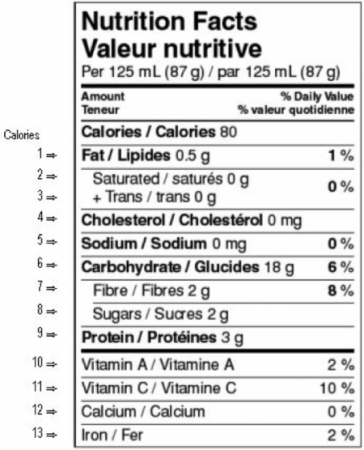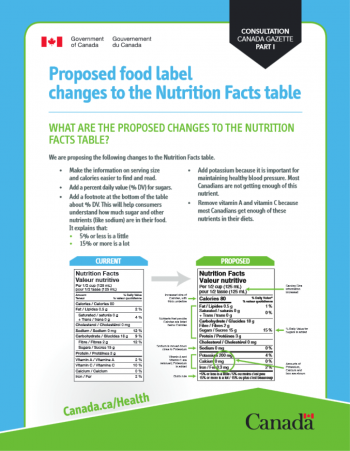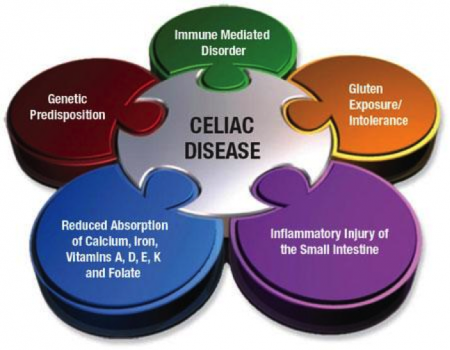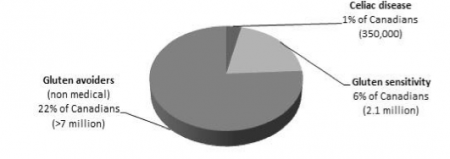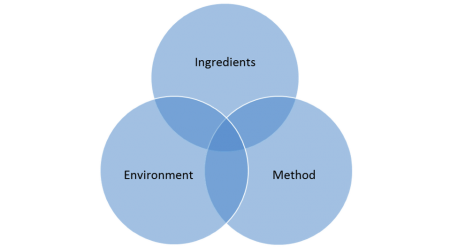Micronutrients are those nutrients that do not provide calories or energy, such as vitamins and minerals.
Vitamins
Vitamins are organic compounds containing hydrogen and carbon. Some vitamins also contain oxygen, nitrogen, and/or sulphur. With the possible exception of vitamin K, our bodies cannot produce vitamins. We must acquire these essential nutrients either through the foods we eat or by taking vitamin supplements. The body needs vitamins to ensure proper nervous system functions, to build strong bones, and to form blood cells. In addition, vitamins are needed to convert food into energy and so are essential for basic metabolism.
Vitamins fall into two classifications: fat soluble and water soluble. Fat soluble vitamins include vitamins A, D, E, and K. These vitamins enter the body by being absorbed with fat in the lower intestine. Fat soluble vitamins that are not immediately used are stored in fat tissues or in the liver. Because they can be stored in the body, fat soluble vitamins do not have to be in our daily diet, but they must be taken on a regular basis so they are stored.
Water soluble vitamins are the B and C vitamins. The B vitamins, often called the B complex, include thiamine (B1), niacin, riboflavin (B2), pyroxidine (B6), pantothenic acid (once called B3), B12, folic acid, and biotin. None of these vitamins can be stored in the body in adequate amounts, so they must be provided daily through dietary intake.
Cooking techniques affect the quality and quantity of vitamins, especially the water soluble ones. For example, vitamin C is easily destroyed if green vegetables (an important source of the vitamin) are overcooked in too much water. In general, high-cooking temperatures and lengthy cooking times can destroy vitamins.
Minerals
Minerals are inorganic substances that do not contain carbon. Minerals come from the earth and cannot be made by the body. They are found in plant matter, meats, and/or dairy products. They can also be bought and consumed in pure form as supplements or, as in the case of sodium, as a flavour enhancer. Minerals are needed for bone growth, water balance, normal muscle functioning, and other functions.
There are two categories of minerals: major minerals (sometimes called macrominerals or bulk minerals) and trace minerals (sometimes called microminerals). The major minerals include calcium, phosphorus, magnesium, sodium, and potassium. The most important trace minerals are iron, zinc, and iodine.
Calcium
Calcium, along with phosphorus and magnesium, is needed to build and maintain bones and teeth. Calcium is the body’s most abundant mineral that gives strength and rigidity to bones and teeth. It also replenishes blood calcium if needed. Dairy products are the main source of calcium, although small whole fish such as sardines and dark green vegetables, beet greens, and broccoli contain significant amounts of calcium. There is some controversy about how much calcium should be in an adult’s diet. From the mid-1990s, research suggested that postmenopausal women should take calcium supplements to prevent bone loss and osteoporosis, while more recent studies have found that calcium supplements may not prove to be effective (Brody, 2013).
Phosphorous
Phosphorous is also a major factor in building healthy bones and teeth. Phosphorous combines with calcium to form the skeleton structure. It is also needed for cell growth and repair, kidney function, nutrient metabolism, muscle contraction, and the digestion of two B vitamins: riboflavin and niacin. Phosphorus is found in meats, whole grain flour and cereals, nuts, eggs, fish, poultry, and cheese. Phosphorus is usually found in foods high in calcium, although the best source is meat.
Magnesium
Magnesium helps bones form and grow. It is also important for cardiac muscle function and maintenance, and plays an important role in the chemical reactions of many enzymes. Magnesium is mainly found in green leafy vegetables, legumes (including nuts), seafood, cocoa, and whole grains.
Sodium
Salt, or sodium chloride, consists of approximately 40% sodium and 60% chloride. Sodium intake should be monitored in the daily diet. Most salts are ingested from processed, pre-packaged, and ready-to-serve foods, which amounts to 77% of daily salt consumption. While 12% is naturally present in food, 5% is added during cooking, and 6% is added during meals as shown by the sodium detector. Salt is a contributing factor to chronic diseases such as cardiovascular disease and high blood pressure.
Sodium (along with potassium) is needed for the normal functioning of nerves and muscles. Both minerals are critical components in maintaining water balance and mineral concentration levels in cells.
Although sodium is needed by the body, it is a mineral that most people get too much of in their daily diet. Health Canada suggests that individuals should refrain from adding salt to their food and should purchase commercial foods that are low in salt. The government faces ongoing challenges to convince food manufacturers to reduce the amount of sodium added to processed and prepared foods.
Potassium
Potassium works in harmony with sodium to regulate water balance and heartbeat. Potassium is found inside body cells while sodium is found in the liquid surrounding the outside of cells. A balance between the concentration of potassium and the concentration of sodium in the body may be a key factor in the prevention of high blood pressure, although the research in this area is inconclusive and may even be contradictory (Harvard School of Public Health, Shifting the Balance of Sodium and Potassium in Your Diet, n.d.). The potassium-sodium balance is affected when there is a substantial loss of both minerals during heavy exercise or when experiencing diarrhea or vomiting.
The replacement of lost minerals is best accomplished from natural food sources. However, a person may have to take salt pills or potassium supplements when large amounts of fluid are lost due to vomiting, diarrhea, or excessive sweating (caused by hard labour or exercise). The best dietary sources for potassium include green leafy vegetables, bananas, oranges and orange juice, potatoes, apricots, raisins, and cantaloupe.
Iron
Iron is an important component of hemoglobin, which is the part of a red blood cell that carries oxygen from the lungs to the cells and waste products from the cells back to the lungs for exhalation. Iron is also needed for the efficient functioning of many parts of the enzyme system. Iron deficiency is one of the most common nutritional deficiencies in North America, particularly among women and young children. A lack of iron can lead to iron-deficiency anemia, a disease that is characterized by muscle weakness, fatigue, and listlessness. Iron deficiency in children has been associated with irritability, hyperactivity, and a less than adequate attention span. Too much iron in the system can also lead to problems such as toxic accumulations in the heart, liver, and pancreas.
Dietary iron is in two forms: heme and non-heme. The heme form is more easily absorbed by the body. Heme iron is only found in animal tissue where it typically makes up about 40% of all the iron found in the meat. Dietary iron has a difficult time entering the blood system as only a small percentage of the available iron is absorbed. The richest sources of iron are the organ meats (such as kidneys and liver), fish, poultry, shellfish, legumes, dried fruits, eggs, and whole grain breads and cereals. Although some leafy vegetables such as spinach are iron rich, it is non-heme iron and so is not easily absorbed into the body. The actual iron requirements per day are about 1 mg, but because of iron’s poor absorption rate, Health Canada recommends a dietary intake eight to ten times more than that. Table 7 gives the recommended daily iron requirements.
| Age (Years) | Sex | Total Iron Requirement (mg/day) | Dietary Intake (mg/day) |
| 1-2 | M/F | 0.7 | 6.0 |
| 3-5 | M/F | 0.7 | 6.0 |
| 6-11 | M/F | 1.0 | 8.0 |
| 12-15 | M | 1.2 | 10 |
| 12-15 | F | 1.6 | 13 |
| 16-18 | M | 1.2 | 10 |
| 16-18 | F | 1.4 | 12 |
| 19+ | M | 1.1 | 9.0 |
| 19+ | F | 1.7 | 13 |
| Post-menopausal | F | 1.0 | 8.0 |
| 65+ | M/F | 1.0 | 8.0 |
Table 7: Iron requirements
Vitamin C may increase the amount of dietary iron absorbed in the digestive tract. Some grains as well as tannic acid found in coffee and tea may bind dietary iron and eliminate it before the body can absorb it. Antacids and aspirin can cause iron deficiencies.
Zinc
Zinc is found in over 70 enzymes in the body including those involved in synthesizing protein, digesting food, transporting carbon dioxide and absorbing vitamins. Zinc also helps in the formation of insulin and the building of cell membranes. Zinc plays a crucial role in the development of the reproductive organs, and a zinc deficiency can lead to low sperm counts in males.
Zinc is found in both animal and vegetable products but is more readily available in animal sources. Meat, liver, seafood (particularly raw or smoked oysters), eggs, brewer’s yeast, wheat germ, pumpkin seeds, and nuts are all good sources of zinc. However, vegetarians must include enough dietary zinc to compensate for the fact that the body cannot easily absorb vegetable zinc. Vegetarians should note that there is some evidence suggesting that fibre and phytates (a compound commonly found in grains, legumes and nuts) binds zinc and so impedes its absorption by the body (Hunt, 2003). This means vegetarians should include enough dietary zinc to compensate for the amount of zinc that may pass through the digestive tract without being absorbed.
Iodine
Iodine is essential for the normal functioning of the thyroid gland, which produces the hormone thyroxine, which in turn regulates energy metabolism in the body. A lack of iodine can lead to goiter problems: the reduction of mental reactions, lethargy, and obesity. Iodine deficiencies are rare in North America because table salt is iodine fortified. Other dietary sources of iodine include fish, shellfish, kelp, some mushrooms, and garlic.

